Chapter 13.08
CROSS-CONNECTIONS
Sections:
13.08.020 Purpose and application.
13.08.030 Cross-connections regulated.
13.08.040 Backflow prevention assembly requirements.
13.08.054 Temporary meters and hydrant valves.
13.08.060 Right-of-way encroachment.
13.08.070 Multiple connections.
13.08.090 Installation requirements.
13.08.100 Annual testing and repair of assemblies.
13.08.110 Maintenance of assemblies.
13.08.115 Responsibilities of backflow prevention assembly testers.
13.08.140 Repealed.
13.08.150 Repealed.
13.08.160 Repealed.
13.08.170 Repealed.
13.08.180 Repealed.
13.08.190 Repealed.
13.08.210 Responsibilities of property owners and renters.
13.08.220 Termination of service.
13.08.240 Falsifying information.
13.08.010 Definitions.
For the purposes of this chapter, the following definitions shall apply unless the context clearly indicates or requires a different meaning. If a word or term used in this chapter is not contained in the following list, its definition, or other technical terms used, shall have the meanings or definitions listed in the Oregon Administrative Rules, Chapter 333, or the most recent edition of the Manual of Cross-Connection Control published by the Foundation for Cross-Connection Control and Hydraulic Research, University of Southern California (USC).
(1) “Approved backflow prevention assembly” or “backflow assembly” or “assembly” means an assembly to counteract backpressure or prevent backsiphonage. This assembly must appear on the list of approved assemblies issued by the Oregon Health Authority.
(a) “Reduced pressure principle backflow prevention assembly” or “reduced pressure principle assembly” or “RP” means an assembly containing two independently acting approved check valves together with a hydraulically operated, mechanically independent pressure differential relief valve located between the check valves and at the same time below the first check valve. The assembly shall include properly located test cocks and two tightly closing shut-off valves.
(b) “Reduced pressure detector assembly” or “RPDA” means an approved assembly consisting of two approved reduced pressure backflow assemblies, set in parallel, equipped with a meter on the bypass line to detect small amounts of water leakage or use. The assembly should include properly located test cocks and two tightly closing shut-off valves.
(c) “Double check valve backflow prevention assembly” or “double check assembly” or “double check” or “DCVA” means an assembly which consists of two independently operating check valves which are spring-loaded or weighted. The assembly comes complete with a resilient seated shut-off valve on each side of the checks, as well as test cocks to test the checks for tightness.
(d) “Double check detector assembly” or “DCDA” means an assembly which consists of two independently operating check valves which are spring-loaded or weighted. The assembly comes complete with a shut-off valve on each side of the checks, as well as test cocks to test the checks for tightness. It shall also be provided with a factory bypass arrangement with a meter and a minimum of an approved double check assembly.
(2) “Auxiliary supply” means any water source or system other than the city of St. Helens water system.
(3) “Backflow” means the flow in the direction opposite to the normal flow or the introduction of any foreign liquids, gases, or substances into the water system of the city.
(4) “Certified backflow assembly tester” means a person who has successfully completed and maintains all requirements as established by the Oregon Health Authority to be a tester in the state of Oregon.
(5) “Certified cross-connection control specialist” shall mean a person who has successfully completed and maintains all requirements as established by the Oregon Health Authority to be a specialist in the state of Oregon.
(6) “City water system” shall refer to and mean the city of St. Helens water system, which shall include wells, treatment mechanisms or processes, pumping stations, reservoirs, supply trunk or feeder lines, service lines, meters and all other appurtenances, device lines and items necessary to the operation of the system and to supply water service to individual property or premises and shall include the city of St. Helens potable water with which the system is supplied.
(7) “Contamination” means the entry into or presence in a public water supply system of any substance which may be deleterious to health and/or quality of the water.
(8) “Cross-connection” means any physical arrangement where a potable water supply is connected, directly or indirectly, with any other non-drinkable water system, or auxiliary water system, sewer, drain conduit, swimming pool, storage reservoir, plumbing fixture, swamp cooler, or any other device which contains, or may contain, contaminated water, sewage, or other liquid of unknown or unsafe quality which may be capable of imparting contamination to the public water system as a result of backflow. Bypass arrangements, jumper connections, removable sections, swivel or changeover devices, or other temporary or permanent devices through which, or because of which, backflow may occur are considered to be cross-connections.
(9) “Degree of hazard” means the non-health hazard or health hazard classification that shall be assigned to all actual or potential cross-connections.
(a) “Health hazard” means an actual or potential threat of contamination of a physical, chemical or biological nature to the public potable water system or the consumer’s potable water system that would be a danger to health.
(b) “Non-health hazard” means the classification assigned to an actual or potential cross-connection that potentially could allow a substance that may be objectionable, but not hazardous to one’s health, to backflow into the potable water supply.
(10) “Mobile units” shall mean units that are temporary in nature, connecting to the water system through a legally permitted hydrant, hose bib, or other appurtenance of a permanent nature that is part of the city of St. Helens water system or a permanent water service to a premises. Examples can include but are not limited to the following: water trucks, pesticide applicator vehicles, chemical mixing units or tanks, waste hauler’s trucks or units, sewer cleaning equipment, carpet or steam cleaning equipment other than homeowner use, rock quarry or asphalt/concrete batch plants or any other mobile equipment or vessel that poses a threat of backflow in the city of St. Helens water system. Uses that are excluded from this definition are recreational vehicles at assigned sites or parked in accordance with other city of St. Helens policies pertaining to recreational vehicles and homeowner devices that are used by the property owner in accordance with other provisions of this, or other, city of St. Helens policies pertaining to provision of water service to a premises.
(11) “OHA” means the Oregon Health Authority.
(12) “OAR” means Oregon Administrative Rules.
(13) “Persons” means a natural person (individual), corporation, company, city, partnership, firm, limited liability company, joint venture company, and other such entity.
(14) “Pollution hazard” means an actual or potential threat to the physical properties of the water system or the potability of the public or the consumer’s potable water system but which would not constitute a health or system hazard, as defined. The maximum intensity of pollution to which the potable water system could be degraded under this definition would cause minor damage to the system or its appurtenances.
(15) “Premises” means any piece of property to which water is provided, including, but not limited to, all improvements, mobile structures, and other structures located on it.
(16) “In-premises protection” means the appropriate backflow prevention within the consumer’s water system at or near the point at which the actual or potential cross-connection exists.
(17) “Premises isolation” means the appropriate backflow prevention at the service connection between the public water system and the premises. This location will be at or near the property line and downstream from the service connection meter.
(18) “Public works” or “city” or “the city” means the public works department of the city of St. Helens or designee.
(19) “Resident” means a person or persons living within the area(s) served by the city of St. Helens water system.
(20) “Retrofitting” means to furnish a service connection with parts or equipment made available after the time of construction or assembly installation.
(21) “Specialist” means an Oregon Health Authority-certified cross-connection specialist, either employed with the city of St. Helens or contracted by the city of St. Helens.
(22) “Submerged heads” means irrigation sprinkling or delivery devices that are located below the surface of the landscaped area in which they are installed.
(23) “Supervisor” shall mean the public works supervisor or his/her designee.
(24) “Thermal expansion” means the pressure created by the expansion of heated water.
(25) “Written program plan” or “WPP” shall mean the city’s current cross-connection control written program plan. (Ord. 3200 § 1 (Att. A), 2015; Ord. 2743 § 1, 1997)
13.08.020 Purpose and application.
The purpose of this chapter is to protect the water supply of the city of St. Helens public works department from contamination or pollution due to any existing or potential cross-connection and to comply with Oregon Administrative Rules 333-061-0070, 333-061-0071, 333-061-0072, 333-061-0073 and 333-061-0074 or as amended. This chapter applies throughout the city of St. Helens water system and to every premises and property served by the city of St. Helens water system. It applies to all premises, regardless of date of connection to the city of St. Helens water system. Every owner, occupant or person in control of any concerned premises is responsible for the terms and provisions contained in this chapter. (Ord. 3200 § 1 (Att. A), 2015; Ord. 2743 § 2, 1997)
13.08.030 Cross-connections regulated.
(1) No cross-connections shall be created, installed, used or maintained within the area(s) served by the city of St. Helens water system, except in accordance with this chapter.
(2) The specialist shall carry out or cause surveys to be carried out to determine if any actual or potential cross-connection exists. If found necessary, an assembly commensurate with the degree of hazard will be required at the service connection.
(3) The owner, occupant or person in control of any given premises is responsible for all cross-connection control within the premises.
(4) All premises found on Table 48 of the OAR shall install a reduced pressure backflow assembly at the service connection in accordance with this chapter.
(5) It is the responsibility of the property owner/occupant to purchase, install, test, repair and maintain all backflow assemblies.
(6) If there is a change in ownership of any and all property within the city’s service area, it shall be the responsibility of the new owner to determine that all assemblies are in compliance with this chapter.
(7) The use of any type of chemical spray attachment connected to the premises plumbing, including garden hose fertilizers and pesticide applicators, is not allowed within the city of St. Helens water system without proper protection from the potential of backflow occurring.
(8) The use of any type of radiator flush kits attached to the premises plumbing is not allowed within the city of St. Helens water system without proper protection from backflow occurring. (Ord. 3200 § 1 (Att. A), 2015; Ord. 2743 § 3, 1997)
13.08.040 Backflow prevention assembly requirements.
A specialist employed by or under contract with the city of St. Helens shall determine the type of backflow assemblies to be installed within the city of St. Helens water system. All assemblies shall be installed at the service connection unless it is determined by the specialist and approved by the public works supervisor that in-premises protection would be adequate. An approved assembly shall be required in each of the following circumstances, but the specialist is in no way limited to the following circumstances:
(1) In the case of any premises where there is any material dangerous to health which is handled in such a fashion as to permit entry into potable water system, the potable water system shall be protected by an approved air gap separation or an approved reduced pressure principle backflow prevention assembly.
(2) When the nature and extent of any activity at a premises, or the materials used in connection with any activity on the premises, or materials stored at a premises, could contaminate or pollute the potable water supply.
(3) When a premises has one or more cross-connections as that term is defined in SHMC 13.08.010(8).
(4) When internal cross-connections are present that are not correctable.
(5) When intricate plumbing arrangements are present making it impractical to ascertain whether cross-connections exist.
(6) When the premises has a repeated history of cross-connections being established or reestablished.
(7) When entry to the premises is restricted so that surveys for cross-connections cannot be made with sufficient frequency to assure cross-connections do not exist.
(8) When materials are being used such that, if backflow should occur, a health hazard could result.
(9) When an appropriate cross-connection survey report form has not been filed with the city of St. Helens public works supervisor.
(10) Any and all used water return systems.
(11) If an in-premises assembly has not been tested or repaired as required by this chapter, the installation of a reduced pressure principle assembly will be required at the service connection.
(12) There is piping or equipment for conveying liquids other than potable city of St. Helens water and that piping or other equipment is under pressure and installed and operated in a manner that could cause a cross-connection.
(13) When installation of an approved backflow prevention assembly is deemed by a specialist to be necessary to accomplish the purpose of this chapter.
(14) Wherever reclaimed water or separate irrigation water is used on premises.
(15) When there is a premises with an auxiliary water supply which is interconnected to the city of St. Helens water service or supply system. (Ord. 3200 § 1 (Att. A), 2015; Ord. 2743 § 4, 1997)
13.08.041 New construction.
(1) On all new nonresidential construction, an approved backflow assembly shall be installed at the service connection. The type of the assembly will be commensurate with the degree of hazard as determined by a specialist.
(2) When a building is constructed on commercial premises, and the end use of the building is not determined or could change, a reduced pressure principle backflow prevention assembly shall be installed at the service connection to provide protection of the public water supply in the event of the most hazardous use of the building. (Ord. 3200 § 1 (Att. A), 2015)
13.08.042 Retrofitting.
Retrofitting shall be required at all service connections where an actual or potential cross-connection exists, and wherever else the city of St. Helens deems retrofitting necessary to comply with the OAR, this chapter and the city’s WPP. (Ord. 3200 § 1 (Att. A), 2015)
13.08.043 Irrigation systems.
All irrigation systems shall be protected according to the Uniform Plumbing Code. In the event any system is equipped with an injector system, a reduced pressure principle assembly will be required at the service connection. (Ord. 3200 § 1 (Att. A), 2015)
13.08.044 Thermal expansion.
If a closed system has been created by the installation of a backflow prevention assembly, or other appurtenances, it is the responsibility of the property owner, the occupant, or person in control of the property to eliminate the possibility of damage from thermal expansion in accordance with the Plumbing Code. (Ord. 3200 § 1 (Att. A), 2015)
13.08.050 Mobile units.
(1) Any mobile unit or apparatus, as defined in SHMC 13.08.010(10), which uses the water from any premises within the city of St. Helens water system must first obtain a permit from the city of St. Helens and be inspected to assure an approved air gap or a reduced pressure principle assembly is installed on the unit. These mobile units will include, but are not limited to, carpet-cleaning vehicles, water-hauling vehicles, street-cleaning vehicles that use water, portable toilet-hauling and water service vehicles, and septic tank-cleaning vehicles that use water. A fixed air gap or backflow assembly mounted either on the truck or piping system may be required.
(2) The city reserves the right to revoke the permit if the owner fails to comply with above procedures. (Ord. 3200 § 1 (Att. A), 2015; Ord. 2743 § 5, 1997)
13.08.054 Temporary meters and hydrant valves.
Backflow protection will be required on all temporary meters and hydrant valves before any use. The type of assembly will be commensurate with the degree of hazard and will be determined on a case-by-case basis by a city of St. Helens specialist. (Ord. 3200 § 1 (Att. A), 2015)
13.08.056 Plumbing Code.
As a condition of water service, customers shall install, maintain, and operate their piping and plumbing systems in accordance with the current Uniform Plumbing Code, or as amended. If there is a conflict between this chapter and the Plumbing Code, the more stringent supersedes. (Ord. 3200 § 1 (Att. A), 2015)
13.08.060 Right-of-way encroachment.
No person shall install or maintain a backflow prevention assembly upon or within any city right-of-way unless approved by the city. (Ord. 3200 § 1 (Att. A), 2015; Ord. 2743 § 6, 1997)
13.08.070 Multiple connections.
Any premises requiring multiple service connections for adequacy of supply and/or fire protection will be required to install a backflow assembly on each of the additional service lines to the premises. The assembly will be commensurate with the degree of potential hazard that could occur in the event of an interconnect between any of the buildings on the premises. (Ord. 3200 § 1 (Att. A), 2015; Ord. 2743 § 7, 1997)
13.08.080 Access to premises.
Authorized personnel of the city of St. Helens, with proper identification and sufficient notice, shall have access during the hours of 8:00 a.m. to 5:00 p.m. to all parts of a premises and within the structure to which water is supplied. However, if any owner, occupant or person in control refuses authorized personnel access to a premises, or to the interior of a structure, during these hours for inspection, a reduced pressure principle assembly must be installed at the service connection to that premises. (Ord. 3200 § 1 (Att. A), 2015; Ord. 2743 § 8, 1997)
13.08.090 Installation requirements.
All backflow prevention assembly installations shall follow the requirements as stipulated by the city of St. Helens and the current OAR Chapter 333, Division 061, as amended.
If the premises isolation assembly is allowed to be installed at an alternate location, the city of St. Helens must have access to the assembly. No connections can be made between the meter and the backflow assembly.
The type of backflow prevention assembly required shall be commensurate with the degree of hazard that exists and must, at all times, meet the standards of the Oregon Health Authority. All backflow prevention assemblies required under this section shall be of a type and model approved by the OHA. (Ord. 3200 § 1 (Att. A), 2015; Ord. 2743 § 9, 1997)
13.08.100 Annual testing and repair of assemblies.
All backflow prevention assemblies installed within the area(s) served by the city of St. Helens shall be tested immediately upon installation, and at least annually thereafter, by an OHA certified backflow assembly tester. All such assemblies found not functioning properly shall be promptly repaired or replaced at the expense of the owner, occupant or person in control of the premises. In the event an assembly is moved, repaired or replaced it must be retested immediately.
All repairs on backflow assemblies within the city of St. Helens service area must be performed according to all state and county regulations. (Ord. 3200 § 1 (Att. A), 2015; Ord. 2743 § 10, 1997)
13.08.110 Maintenance of assemblies.
Backflow prevention assemblies shall be maintained, tested and repaired in accordance with the requirements set out in this chapter, the city’s WPP, the OAR and all applicable state agencies’ regulations. The assembly owner is responsible for protecting their assembly from freezing and vandalism.
In the event an assembly is not properly tested and repaired, the city of St. Helens will have the assembly tested and repaired and apply all costs associated with this to the assembly owner’s utility bill. (Ord. 3200 § 1 (Att. A), 2015; Ord. 2743 § 11, 1997)
13.08.115 Responsibilities of backflow prevention assembly testers.
(1) All backflow assembly testers operating within the city of St. Helens water system service area shall be certified in accordance with all applicable regulations of the OHA and must abide by the requirements of this chapter and the city’s WPP.
(2) Persons certified as backflow assembly testers shall agree to abide by all requirements of the United States Occupational Safety and Health Administration (“OSHA”) and Oregon Occupational Safety and Health Administration (“OR-OSHA”).
(3) It is the responsibility of backflow assembly testers to submit records of all backflow assembly test reports to the city of St. Helens within 10 days of completing the test. (Ord. 3200 § 1 (Att. A), 2015)
13.08.120 Pressure loss.
Any reduction in water pressure caused by the installation of a backflow assembly is not the responsibility of the city. (Ord. 3200 § 1 (Att. A), 2015; Ord. 2743 § 12, 1997)
13.08.130 Cost of compliance.
All costs associated with purchase, installation, surveys, testing, replacement, maintenance, parts and repairs of the backflow prevention assembly, and all costs associated with enforcement of this chapter, are the financial responsibility of the property owner, occupant, or other person in control of the premises.
The fees for the inspection and testing will be set by resolution of the city council. (Ord. 3200 § 1 (Att. A), 2015; Ord. 2743 § 13, 1997)
13.08.140 Installation standards and specifications.
Repealed by Ord. 3200. (Ord. 2743 § 14, 1997)
13.08.150 Reduced pressure principle detector backflow prevention assembly (RPDA).
Repealed by Ord. 3200. (Ord. 2743 § 15, 1997)
13.08.160 Double check valve backflow prevention assembly (DC).
Repealed by Ord. 3200. (Ord. 2743 § 16, 1997)
13.08.170 Double check detector backflow prevention assembly (DCDA).
Repealed by Ord. 3200. (Ord. 2743 § 17, 1997)
13.08.180 Pressure vacuum breaker backflow prevention assembly (PVB).
Repealed by Ord. 3200. (Ord. 2743 § 18, 1997)
13.08.190 Air gap separation.
Repealed by Ord. 3200. (Ord. 2743 § 19, 1997)
13.08.200 Fire systems.
An approved double check detector assembly (DCDA) shall be the minimum protection on all new fire sprinkler systems using piping material that is not approved for potable water use and/or that does not provide for periodic flow-through. A reduced pressure principle detector assembly (RPDA) must be installed if any solution other than the potable water can be introduced into the sprinkler system.
Retrofitting on fire sprinkler systems will be required in each of the following circumstances:
(1) Where improper maintenance has occurred;
(2) On all health hazard systems;
(3) Wherever a specialist deems necessary; or
(4) Wherever required by the OAR.
In the event an assembly is installed on a designated lateral, a detector assembly commensurate with the degree of hazard will be required. (Ord. 3200 § 1 (Att. A), 2015; Ord. 2743 § 20, 1997)
13.08.210 Responsibilities of property owners and renters.
It is the responsibility of all property owners and their renters to abide by the conditions of this chapter. In the event of any changes to the plumbing system, it is the responsibility of the property owners to notify the city. (Ord. 3200 § 1 (Att. A), 2015; Ord. 2743 § 21, 1997)
13.08.220 Termination of service.
Failure on the part of any owner, occupant or person in control of the premises to install a required assembly, have it tested a minimum of annually and repaired if necessary, and/or to discontinue the use of all cross-connections and to physically separate cross-connections in accordance with this chapter is sufficient cause for the discontinuance of public water service to the premises pursuant to Oregon Administrative Rules 333-061-0070, or as amended. In the case of an extreme emergency or where an immediate threat to life or public health is found to exist, discontinuance or termination of public water service to the premises shall be immediate.
In lieu of termination of service, the city of St. Helens may, at the property owner’s expense, install a reduced pressure assembly at the meter. Testing, maintenance and repair of the assembly will be the responsibility of the property owner. (Ord. 3200 § 1 (Att. A), 2015; Ord. 2743 § 23, 1997)
13.08.230 Recovery of costs.
Any water customer violating any of the provisions of this chapter and who causes damage to or impairs the city of St. Helens water system, including, but not limited to, allowing contamination, pollution, any other solution or used water to enter the city of St. Helens water system, shall be liable to the city of St. Helens for any expense, loss or damage caused by such violation. The city of St. Helens shall collect from the violator the cost incurred by the city of St. Helens for any cleaning, purifying, repair or replacement work or any other expenses caused by the violation. Refusal to pay the assessed costs shall constitute a violation of this chapter and shall result in the termination of service.
All cost associated with any disconnect or reconnect fees resulting from the enforcement of this chapter are the sole responsibility of the property owner. (Ord. 3200 § 1 (Att. A), 2015)
13.08.240 Falsifying information.
Any person who knowingly makes any false statement, representation, record, report or other document filed or required to be maintained pursuant to this chapter, or who falsifies, tampers with, or knowingly renders inaccurate any backflow assembly, device or method required under this chapter shall be subject to civil and/or criminal penalties provided by state law. (Ord. 3200 § 1 (Att. A), 2015)

REDUCED PRESSURE PRINCIPLE Standard Detail No. 4:01-1
LARGE ASSEMBLY
NOTES:
1) Large assemblies are those that are 2 1/2″ and larger.
2) Assembly shall not be subject to flooding.
3) Drain lines shall be sized to accommodate full relief valve discharge flow. See flow chart 4:01-2.
4) Reduced pressure backflow assemblies are typically installed above grade in well draining areas, but may be installed below grade if an adequate drain to daylight is provided.
5) The installation on the supply line (ahead of assembly) of a strainer with tapping blowout may be required. See Standard Detail 4:01-3.
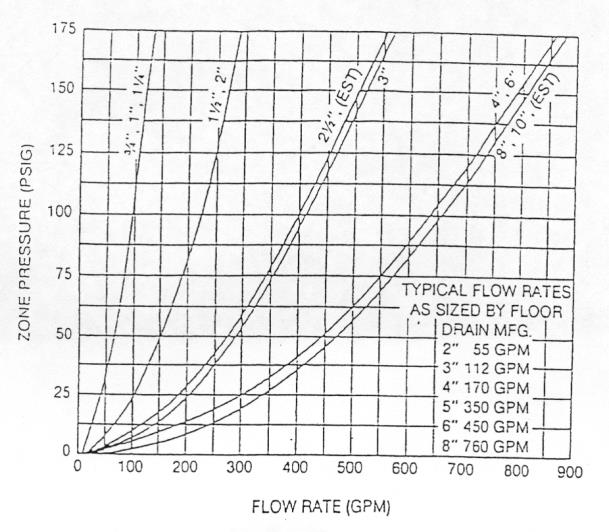
RELIEF VALVE DISCHARGE RATES Standard Detail 4:01-2
FOR REDUCED PRESSURE BACKFLOW
ASSEMBLIES
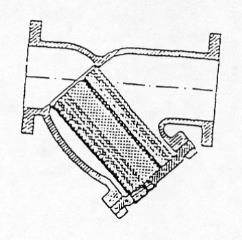
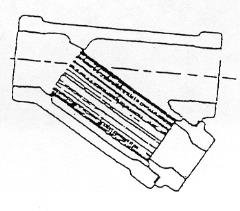
STRAINERS Standard Detail No. 4:01-3
One of the most common causes of backflow prevention assembly failure is the accumulation of sand, scale, or debris trapped in the assembly. This debris can cause the assembly to fail its required testing and can contribute to a shorter working life span of the assembly.
To minimize maintenance and repairs, it is recommended that a strainer with removable screen is installed immediately upstream on the supply line of the assembly. Also, periodically remove and clean strainer screens.

REDUCED PRESSURE PRINCIPLE Standard Detail No. 4:01-4
SMALL ASSEMBLY
NOTES:
1) Assembly must be protected from freezing.
2) Removable insulated covers can be used.
3) Enclosures must be in area not subject to flooding.
4) The installation on the supply line (ahead of assembly) of a strainer with tapping blowout is recommended. See Standard Detail No. 4:01-3.

REDUCED PRESSURE PRINCIPAL Standard Detail No. 4:01-5
DETECTOR ASSEMBLY
NOTES:
1) Assembly shall not be subject to flooding.
2) Drain lines shall be sized to accommodate full relief valve discharge flow. See flow chart 4:01-2.
3) Reduced pressure backflow assemblies are typically installed above grade in well draining areas, but may be installed below grade if an adequate drain to daylight is provided.
4) The installation on the supply line (ahead of assembly) of a strainer with tapping blowout may be required. See Standard Detail 4:01-3.

DOUBLE CHECK VALVE Standard Detail No. 4:02-1
LARGE ASSEMBLY
NOTES:
1) Large assemblies are those that are 2 1/2″ and larger.
2) Vault installations require the use of brass pipe plugs in all test cocks.
3) The installation on the supply line (ahead of assembly) of a strainer with tapping blowout may be required. See Standard Detail No. 4:02-3.
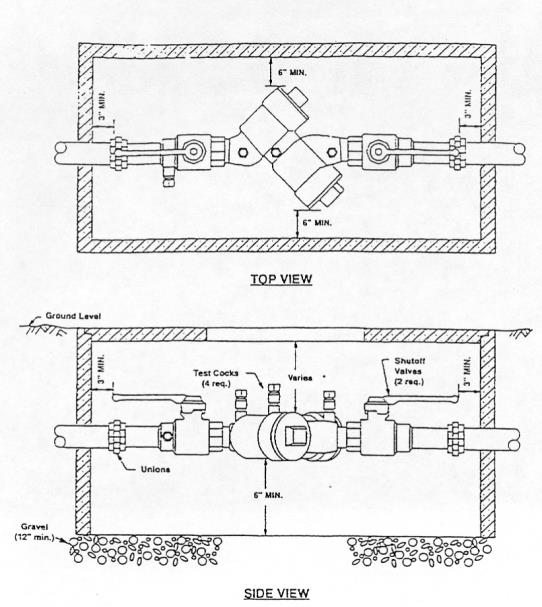
DOUBLE CHECK VALVE Standard Detail No. 4:02-2
SMALL ASSEMBLY
NOTES:
1) Adequate space must be allowed for testing and maintenance.
2) Area around assembly must drain well.
3) Vault installations require the use of brass pipe plugs in all test cocks.
4) “Y” pattern assemblies must be installed so that test cocks are pointed up (see drawing above).
5) Thoroughly flush the lines prior to installation of the assembly.
6) Strainers are recommended. See Standard Detail No. 4:02-3.

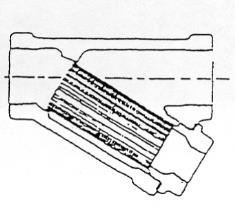
STRAINERS Standard Detail No. 4:02-3
One of the most common causes of backflow prevention assembly failure is the accumulation of sand, scale, or debris trapped in the assembly. This debris can cause the assembly to fail its required testing and can contribute to a shorter working life span of the assembly.
To minimize maintenance and repairs, it is recommended that a strainer with removable screen is installed immediately upstream on the supply line of the assembly. Also, periodically remove and clean strainer screens.
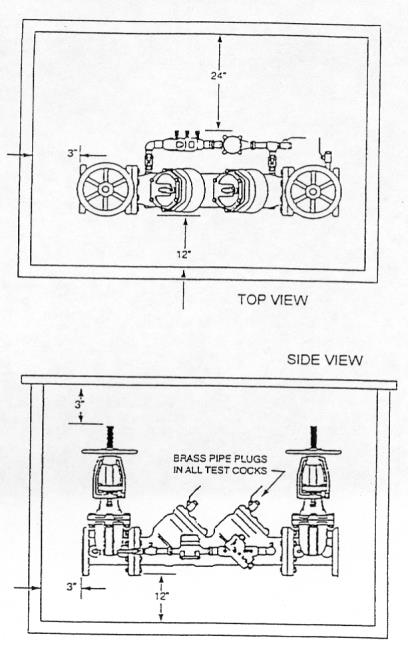
DOUBLE CHECK DETECTOR Standard Detail No. 4:03-1
ASSEMBLY
NOTES:
1) Assemblies 2″ and smaller shall have 3″ clearance below and on sides.
2) Vault installations require the use of brass pipe plugs in all test cocks.
3) The installation on the supply line (ahead of assembly) of a strainer with tapping blowout may be required. See Standard Detail 4:02-3.

PRESSURE VACUUM BREAKER Standard Detail No. 4:04-1
NOTES:
1) Downstream control valves or shut-offs are allowed.
2) Install assembly at least 12″ above highest downstream piping.
3) No pumps or backpressure source allowed.
4) No chemical addition into system allowed.
5) Pressure vacuum breakers must be tested by a certified backflow prevention assembly tester upon installation and annually thereafter; also when moved and repaired.

AIR GAP SEPARATION Standard Detail No. 4:05-1
NOTES:
1) Provides maximum protection.
2) The vertical, physical separations must be at least twice the diameter of the inlet pipe but never less than one inch.


